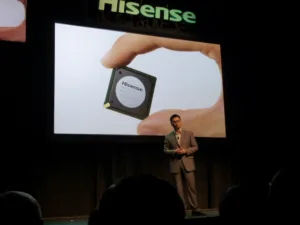Before looking at the new flagship TV sets, we saw Hisense’s more traditional models. One of these is the M7000U, which is a slim (11mm) set with ULED 2.0 technology. It will be released soon in 50″, 55″ and 65″ sizes. We also saw a prototype 8k model that will be released in the USA in 2017; it is already available (by special order) in China.
The third generation of ULED sets – which, as mentioned above, feature higher peak brightness, wider colour gamuts and more dimming zones – will be launched in mid-2016. There was little more information available about these sets than was shared in the press conference. However, we did get a starting price for the 50″ ($600) and 55″ ($700) H8 TVs. These are designed as price disruptive models.
We also learned that Hisense is working on getting THX certification for the H10. This set will be launched in February, for $2,800. The 55″ H9, meanwhile, will cost $1,000.
In terms of Sharp TVs, the N9000 70″ flagship will be launched in July; Hisense is, again, working on THX certification. Prices will start at $3,300. However, the 65″ will be launched in March, for $3,000.
New Roku TVs will join Hisense’s existing 40″ and 48″ sets. They will feature a new universal search, which searches all content sources that the user has access to, not only one. For instance, Amazon, Netflix, Hulu, YouTube, etc. The H4 will be launched in February, for $200 (32″) – $430 (50″). The Sharp-branded N4000 will start at $250 for the 32″ and increase to $600 for the 55″; they will be launched a month later than the H4, in March.
Hisense also produces mobile phones and tablets. However, because these are primarily designed for the Chinese, APAC and LATAM markets, they were not given space in the press conference.
One of the smartphones was confirmed for a US launch: the C20, which will cost €300 (yes, prices were given in euros) and was first seen at IFA. It is an ‘unbreakable’ waterproof unit, with a 5″ 1280 x 720 LCD display. It is IP67-compliant and can take shocks and knocks.
The A1 phone is a 5.5″ model with a dual-rear-camera design. One of the lenses is a 32MP auto focus unit and the the other is a 2MP fixed focus. A 5MP front camera is also integrated. The phone is a dual-SIM model, launched in APAC the week before CES. It costs €400 and ‘may’ be launched in the USA.
Two tablets were on show: the E81 and Vidaa Mirror. The more interesting model is the Vidaa, which has extremely slim bezels. This is because it has no excess electronics, like a camera or SD slot. Instead, the 8.4″ tablet is purely designed for online gaming and entertainment. It has 2560 x 1600 resolution, 350 cd/m² of brightness and a quad-core Cortex A17 processor, with 2GB of RAM and 16GB of storage.
The final tablet was the E81, a last-minute addition to the show – so the stand staff had little information about it. A US launch is TBC. It is a 7″ model with 1280 x 800 resolution, running Android 5.1 and featuring NFC.

